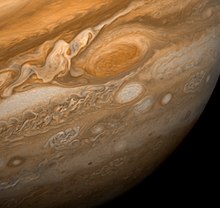外行星
外觀
外行星是太陽系內軌道在主小行星帶外側的行星,因此所指的就是氣態巨行星。依照它們與太陽的距離,依序為:
- 木星:太陽系最大的行星,擁有4顆非常大的衛星。
- 土星:太陽系第2大的行星,有着巨大且明亮的環系統。
- 天王星:太陽系第3大的行星,但質量卻是4顆外行星中最低的[1]。它的自轉軸非常傾斜,幾乎是躺在它公轉太陽的軌道平面上。
- 海王星:太陽系第4大的行星,體積是外行星中最小的,但質量是第3大。它有一顆逆行的大衛星和許多小衛星。
所有的外行星都有環,但除了土星,所有的環從地球看都非常的黯淡[1]。
這些氣態巨行星的另一個特性是他們都有很多的天然衛星,其中的兩顆衛星,佳麗美德和泰坦比水星這顆行星還要大。這一對和埃歐、歐羅巴、卡利斯多和崔頓,也都比矮行星的冥王星和鬩神星大。
這一區域的空間也被為數眾多的半人馬小行星、特洛伊小行星和彗星充斥着。
冥王星從它在1930年被發現後一直被認為是外行星,直到2006年國際天文學聯合會重新定義行星後,才被歸類為矮行星。(參見:古柏帶)。
探測
[編輯]
包括先鋒10號、先鋒11號、航海家1號、航海家2號、尤里西斯號、伽利略號探測器、卡西尼-惠更斯號和新視野號都已經親臨現場探測過。環繞木星的朱諾號和環繞土星的卡西尼號是現在正在進行的探測,計劃的任務還可能包括外行星旗艦任務;還有其它項的建議,像是天王星軌道探測器。卡西尼號和新視野號都曾經飛掠過木星。
使探測外行星容易得多的一項突破概念是利用行星的重力助推[2]。在1960年代發現太空船接近像木星這樣的行星時,可以被加速到更高的速度。這允許小推力的火箭也可以用來發射外行星探測器[2]。
另一種有前途的技術,是在深空1號上實驗的離子引擎。離子引擎可以比現在使用的化學燃料火箭推進劑更有效率[2]。
| 太空船 | 發射 (年) |
木星 | 土星 | 天王星 | 海王星 | 結束 (年) |
|---|---|---|---|---|---|---|
| 先鋒10號 | 1972 | 飛越 | 2003 | |||
| 先鋒11號 | 1973 | 飛越 | 飛越 | 1995 | ||
| 航海家1號 | 1977 | 飛越 | 飛越 | - | ||
| 航海家2號 | 1977 | 飛越 | 飛越 | 飛越 | 飛越 | - |
| 伽利略號 | 1989 | 軌道 | 2003 | |||
| 伽利略探針 | 1989 | 進入 | 1995 | |||
| 尤利西斯號 | 1990 | 飛越 | 2009 | |||
| 卡西尼號 | 1997 | 飛越 | 軌道 | - | ||
| 新視野號 | 2006 | 飛越 | - | |||
| 朱諾號 | 2011 | 軌道 | - |
任務概念
[編輯]

任務概念列表:
- 阿爾戈號[3] - 飛越木星、土星、海王星和古柏帶。
- AVIATR(泰坦飛機)[4]
- Chiron Orbiter Mission Concept Study[5]
- Enceladus Flyby & Sample Return Concept Studies[5]
- Enceladus Orbiter Concept Study[5]
- Europa Flyby[6]
- Europa Flyby Study[7]
- Europa Lander[6]
- Europa Lander Study[7]
- Europa Orbiter[6]
- Exploration of Jovian Atmosphere Using Nuclear Ramjet Flyer[8]
- Ganymede Orbiter Concept Study[5]
- Io Observer Concept Study[5]
- Journey to Enceladus and Titan (JET)[9]
- Jupiter Europa Orbiter Study[5]
- Life Investigation For Enceladus (LIFE) - flyby sample return for Enceladus and Saturn's E-ring.[10]
- Neptune-Triton-Kuiper Belt Objects Mission Concept Study[5]
- Saturn Atmospheric Entry Probe Study[5]
- Saturn Ring Observer Concept Study[5]
- Titan Lake Probe Concept Study[5]
- 土衛六-土星系統任務[5]
- Titan Rover[11]
- Trojan Tour Concept Study[5]
- Uranus and Neptune Orbiter and Probe Concept Studies[5]
- 天王星軌道探測器
- Uranus Pathfinder[12]
相關條目
[編輯]- Discovery and exploration of the Solar System
- 太陽系的巨行星:
- 古柏帶
- List of missions to the outer planets
- 歐特雲
參考資料
[編輯]- ^ 1.0 1.1 How big is Neptune? - space.com. Space.com. 2015 [2016-04-04]. (原始內容存檔於2016-04-07). The 2nd-largest planet is Saturn, 3rd-largest is Uranus, 4th-largest is Neptune, while 2nd-most massive planet is Saturn, 3rd-most massive is Neptune, but 4th-most massive is Uranus.
- ^ 2.0 2.1 2.2 Basics of Spaceflight - Chapter 4. Interplanetary Trajectories. [2016-12-23]. (原始內容存檔於2015-08-17).
- ^ Argo - A Voyage Through the Outer Solar System (PDF). [2016-12-24]. (原始內容 (PDF)存檔於2016-03-03).
- ^ AVIATR (PDF). [2016-12-24]. (原始內容存檔 (PDF)於2017-08-12).
- ^ 5.00 5.01 5.02 5.03 5.04 5.05 5.06 5.07 5.08 5.09 5.10 5.11 5.12 Planetary Science Decadal Survey Mission & Technology Studies. [2016-12-24]. (原始內容存檔於2017-12-18).
- ^ 6.0 6.1 6.2 March 2012 OPAG Meeting. [2016-12-24]. (原始內容存檔於2016-03-03).
- ^ 7.0 7.1 OPAG. [2016-12-22]. (原始內容存檔於2012-11-02).
- ^ G. Maise - Exploration of Jovian Atmosphere Using Nuclear Ramjet Flyer (PDF). [2016-12-24]. (原始內容存檔 (PDF)於2016-03-03).
- ^ JET - Cost Capped Titan-Enceladus Proposal. [2016-12-24]. (原始內容存檔於2016-12-24).
- ^ Tsou, et al. - LIFE link courtesy of Future Planetary Exploration (頁面存檔備份,存於互聯網檔案館)
- ^ ARPS Enabled Titan Rover Concept with Inflatable Wheels (PDF). [2016-12-24]. (原始內容 (PDF)存檔於2010-02-06).
- ^ Uranus Pathfinder. [2016-12-24]. (原始內容存檔於2017-06-20).
進階讀物
[編輯]- Solar Power for Outer Planets Study (2007) – NASA Glenn Research Center(頁面存檔備份,存於互聯網檔案館)
- Human Outer Planet Exploration (2003) – NASA Langley Research Center and Princeton University
- Future Exploration of the Outer Planet Satellites: A Decadal Perspective (2009)(頁面存檔備份,存於互聯網檔案館)
